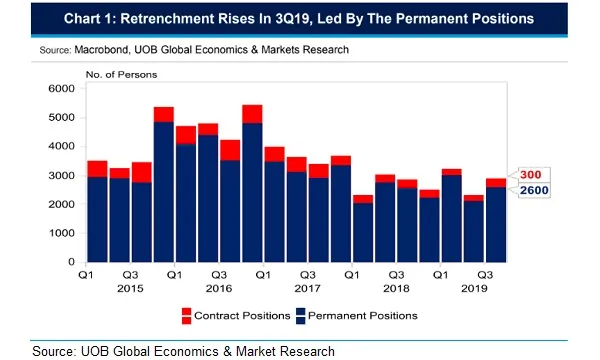
Jobless rate up 2.3% in Q3
The unemployment rate amongst residents rose to 3.2%.
Singapore’s unemployment rate rose marginally to 2.3% in Q3 2019, up from 2.2% in Q2 2019. The uptick in unemployment is seen amongst residents (to 3.2% from 3.1%) and citizens (to 3.3% from 3.2%).
However, Singapore’s employment growth surged by 22,400 in 3Q 2019, significantly higher than 2Q 2019’s gain of 6,200 and a year ago of 16,700.
Also read: Unemployment rate hits 3.3% in Q2
According to UOB, the labour market remains relatively resilient because employment in all three key industries—services, construction, and manufacturing—grew during the quarter. Employment in the services cluster rose tp 16,100 persons in Q3 from Q3 2018’s 13,800 employed people.
The construction sector added 5,300 newly-employed people as a result of robust private and public sector construction activities. The manufacturing sector also saw its headcount rise by 1,200, bucking the fall seen in the last three consecutive quarters.
Furthermore, UOB noted that unemployment remained historically low in Q3. Singapore’s jobless rate previously peaked at 3.3% in Q3 2009.
Government initiatives also helps in upholding the health of Singapore’s labour market. Support schemes include the ‘Adapt and Grow’ initiative, the Career Support Programme (CSP) and the Professional Conversion Programmes (PCPs). “These schemes may have reduced structural unemployment as employees can seek assistance in adapting to changing job demands and reskill for new careers, whilst employers may seek salary support in hiring long-term unemployed Professional, Managers, Executives and Technicians (PMET) jobseekers,” said UOB.
The A&G initiative enabled about 22,000 jobseekers to find work between January and August, of which 12,000 were aged 40 and above, according to data from the Ministry of Manpower.
However, UOB noted that there is a cautious hiring sentiment in the island, unemployment. Back in our labour report in September, with hiring managers preferring to place workers on
shorter workweek or temporary layoff arrangements rather than opting to retrench
workers.
This was reflected in the government’s inflation report for September, where the Monetary Authority of Singapore (MAS) and the Ministry of Trade and Industry stated that labour market conditions “are softening slightly... (which) would lower wage growth in 2019 and 2020”.


![SBR 5 Lorem Ipsum News 2 [8 May]](https://cmg-qa.s3.ap-southeast-1.amazonaws.com/s3fs-public/styles/exclusive_featured_article/public/2025-05/a_hand_pointing_to_a_futuristic_technology_5b87c9d0e3_3.png.webp?itok=M3Hf-9XR)
![SBR 4 Lorem Ipsum [8 May Top Stories]](https://cmg-qa.s3.ap-southeast-1.amazonaws.com/s3fs-public/styles/exclusive_featured_article/public/2025-05/a_hand_pointing_to_a_futuristic_technology_5b87c9d0e3_2.png.webp?itok=2m5Wl0MX)


![Exclusive three SBR 12 Lorem Ipsum [8 May]](https://cmg-qa.s3.ap-southeast-1.amazonaws.com/s3fs-public/styles/exclusive_featured_article/public/2025-05/a_hand_pointing_to_a_futuristic_technology_5b87c9d0e3_11.png.webp?itok=8kn_UIfA)
![SBR 3 Lorem Ipsum [ Exclusive 2]](https://cmg-qa.s3.ap-southeast-1.amazonaws.com/s3fs-public/styles/exclusive_featured_article/public/2025-05/a_hand_pointing_to_a_futuristic_technology_5b87c9d0e3_1.png.webp?itok=YCyjLegJ)
![SBR 2 Lorem Ipsum [8 May]](https://cmg-qa.s3.ap-southeast-1.amazonaws.com/s3fs-public/styles/exclusive_featured_article/public/2025-05/a_hand_pointing_to_a_futuristic_technology_5b87c9d0e3_0.png.webp?itok=_cKD-29o)

![Video [Event News]](https://cmg-qa.s3.ap-southeast-1.amazonaws.com/s3fs-public/styles/event_news_featured_article/public/2025-05/screenshot-2025-05-08-at-4.58.53-pm_0.png.webp?itok=Kud35sMs)
![Event News SBR 9 Lorem Ipsum [8 may]](https://cmg-qa.s3.ap-southeast-1.amazonaws.com/s3fs-public/styles/event_news_thumbnail/public/2025-05/a_hand_pointing_to_a_futuristic_technology_5b87c9d0e3_8.png.webp?itok=DTh_dbYp)
![Event News SBR 9 Lorem Ipsum [8 May]](https://cmg-qa.s3.ap-southeast-1.amazonaws.com/s3fs-public/styles/event_news_thumbnail/public/2025-05/a_hand_pointing_to_a_futuristic_technology_5b87c9d0e3_7.png.webp?itok=vzDAzb6V)
![Event News SBR 8 Lorem Ipsum [8 May]](https://cmg-qa.s3.ap-southeast-1.amazonaws.com/s3fs-public/styles/event_news_thumbnail/public/2025-05/a_hand_pointing_to_a_futuristic_technology_5b87c9d0e3_6.png.webp?itok=jvHFc4P6)
![Video [Event News]](https://cmg-qa.s3.ap-southeast-1.amazonaws.com/s3fs-public/styles/video_thumbnail/public/2025-05/screenshot-2025-05-08-at-4.58.53-pm_0.png.webp?itok=yZnI0YBb)
![Video 1 SBR [8 May]](https://cmg-qa.s3.ap-southeast-1.amazonaws.com/s3fs-public/styles/video_thumbnail/public/2025-05/screenshot-2025-05-08-at-4.58.53-pm.png.webp?itok=9AAeRz_k)

 Advertise
Advertise

